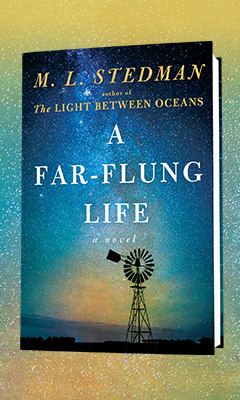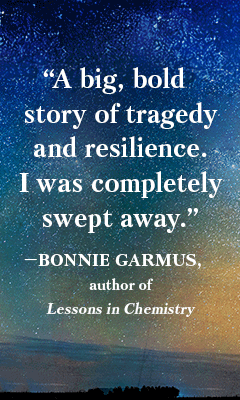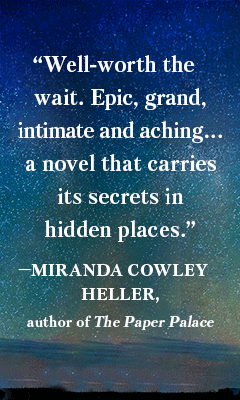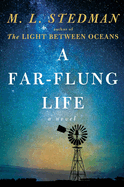A Far-flung Life
by M.L. Stedman
M.L. Stedman (The Light Between Oceans) awes and transports readers with the astonishing A Far-flung Life, a sweeping family drama spanning the latter half of the 20th century. Layers of tragedy and compelling, nuanced characters are set against a vast, indifferent landscape in Western Australia.
The MacBride family has run a sizable sheep station for generations, with quiet success, in a dispersed but close-knit community whose respect they have earned. "The MacBrides had the touch, it was said: sensible but shrewd, careful but not mean." The novel opens with landscape, scenery, and color: red earth, blue sky, dust-green vegetation, the "straight vermilion line" of a road through sparse trees. Against this backdrop, three MacBride men travel "like unpacked Russian dolls" in a Bedford pickup truck across the expanse of their sheep station, "nearly a million arid acres." Phil drives, accompanied by his sons, Warren and Matt, and a trailer full of sheep. It is fitting that the reader meets this landscape before its human inhabitants; Stedman will consistently reinforce that contrast. It is early 1958, and the date, January 10, will reverberate through the MacBride family history for years to come.
Phil MacBride has known since his feet could reach the pedals not to swerve to avoid a kangaroo. But under the January sun, he makes a fateful error. Back at their homestead, hours later, Phil's wife, Lorna, and daughter, Rose, open their door to two policemen, from whom they learn of lives both ended and hanging in the balance. The consequences of the crash that opens Stedman's masterful novel will tumble and tangle MacBride lives for generations. Amid unspeakable tragedy and threads of hope, a note of whimsy cuts through: also introduced in this opening chapter is the outright oddity of a fully rigged pearling lugger. The subject of legend, the boat abides in its own structure, known as "Monty's shed," for the late Montgomery MacBride, Phil's uncle, who won the vessel in a bet but never got to sail it. The MacBrides maintain the tradition of oiling its timbers, keeping spiders and termites at bay, and placing a beer in its bow every year on Monty's birthday. Matt MacBride--thrown from the truck on that January day--as a younger son, was destined not to inherit the sheep station but to make his own way in a larger world. He had longstanding goals and dreams springing from Monty's boat. Now everything has changed; but the pearling lugger remains in its shed, storing potential.
A Far-flung Life follows the remaining MacBrides as they continue to scrape life and livelihood out of a hardscrabble home with fragile concepts of morality and honor, and the power of love. They weather births and death, secrets, and scandals both experienced and kept hidden. Throughout every loss and recovery, their fate remains tied up with the land: "Our lives come and go like these gold-rush towns. We arrive, we grow, we thrive, then we're gone. Then the forgetting happens, and once-solid foundations are barely traces in the earth, from unguessable lives. Whole communities and the ties that bound them are blown away with the dust." Stedman excels at description of both landscape and the human experience, and alternates applying this close attention to the events in her characters' lives and to the larger world in which they live. "In the end, we're all looking for a place to ride out the storm of life. Among all these husks of houses and fossils of trees, we are like hermit crabs, borrowing a shelter for a time, and moving on."
As the MacBrides carry on after the crash, their lives will continue to call upon big themes, including inexorability and change, innocence, and the handling of painful truths. Stedman generally employs a shifting close third-person perspective, allowing her reader to see through one character's eyes and then another's, finding out at different points what they know. This careful reveal not only of events, but of various characters' knowledge of events, is central to the complexity of the MacBrides' secrets. Another significant theme is the tension between memory and forgetting. One young character, in asking questions that his elders can't or won't answer, coins a term, "forgetment," for what is forgotten--"the opposite of a memory." This concept recurs throughout a plot that revolves around what its protagonists can't remember and what they wish they didn't.
Like the heartrending The Light Between Oceans, the MacBrides' story interrogates ideas of right and wrong in specific and complicated cases, and the experience of humans writ small against a vast landscape. "This land has seen improbable things: the evolution of marsupials and monotremes; of flightless birds and animals that fly. It's seen continents split and islands arise. It's seen oceans turn to desert and desert turn to glaciers. And it's watched people drag their little lives across its surface, flat and unforgiving." By the end of this epic and wrenching family saga, readers will care deeply about lives that are "destined to join the vast ocean of human forgetments." Heartbreaking and painfully beautiful, A Far-flung Life will haunt and comfort long past its final page. --Julia Kastner








